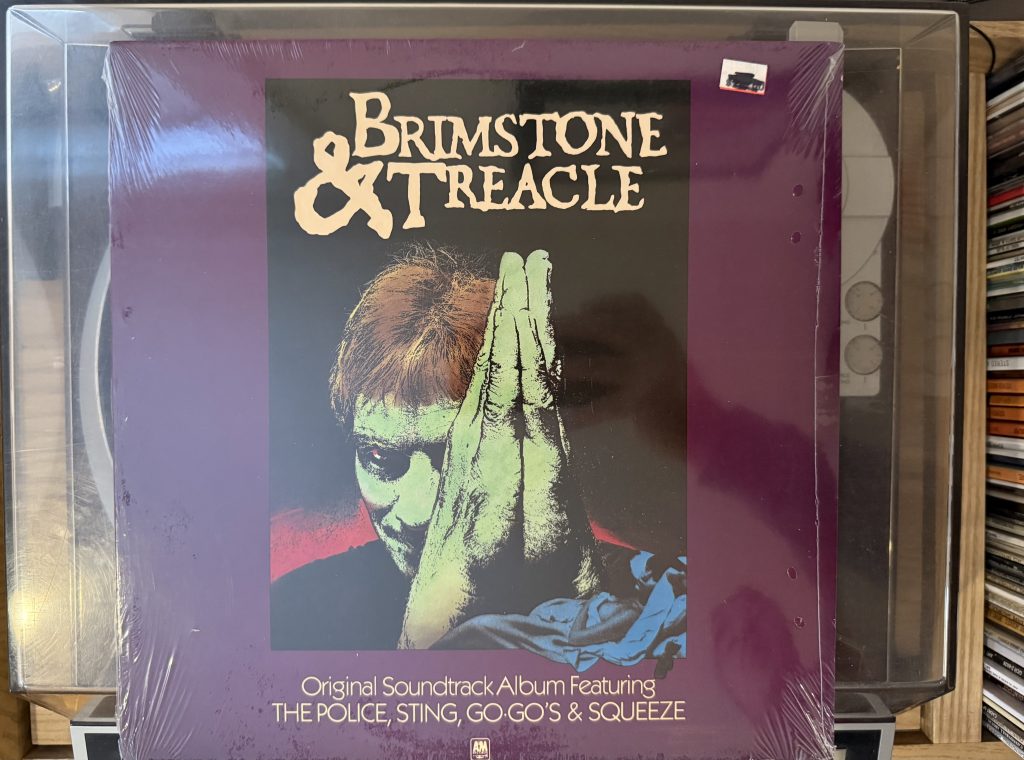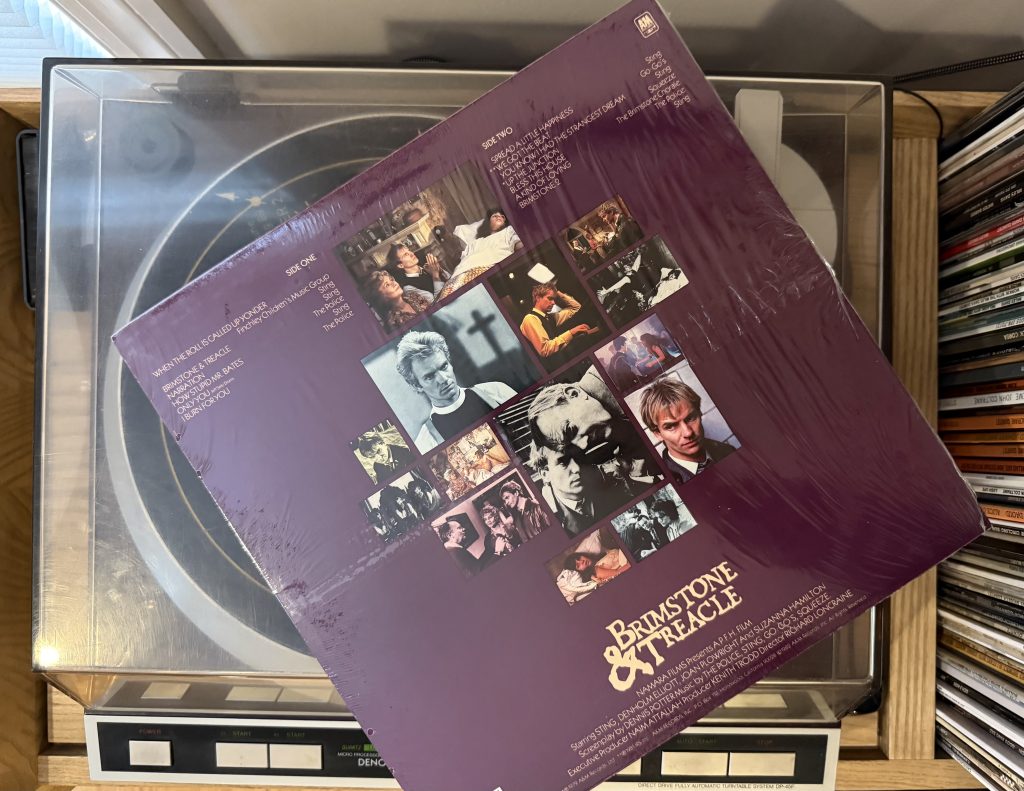
Album of the Week, February 8, 2025
When you’re the frontman of an increasingly successful band, with multiple Grammy awards to your name,1 and you’re photogenic to boot, the well established career move is to extend your brand to other arts—specifically, film. Sting was not immune to this trend, but, as befits a cerebral songwriter given to quoting philosophers in his writing (and rhyming “shake and cough” with “Nabokov”), his initial movie roles were art-house rather than blockbuster: first appearing as Ace Face in the film version of the Who’s Quadrophenia, then his first starring turn in an art house film.
Brimstone & Treacle started out as a BBC television play by Dennis Potter (who also wrote the television serial Pennies from Heaven, substantially rewritten into a 1981 flop starring Steve Martin and Bernadette Peters). The play, about a woman who becomes nonverbal and disabled following an automobile accident, and a mysteriously charismatic young man who charms her religious family with his piety, with predictably awful results, was withdrawn before broadcast by the BBC due to the final scene in which the angelic, or devilish, young man attempts to rape the disabled girl, who is subsequently returned to consciousness and regains full control of her body. —I watched this movie as a Blockbuster rental in 1989, having no idea what I was getting myself into, and was sorry.

The soundtrack, on the other hand, has some redeeming virtues, though tonal consistency is not one of them. The opening begins with a fairly ominous chord in the synths with a rolling slightly squelchy sound atop it, but fades out after about eight measures to the sound of a small brass band and the Finchley Children’s Music Chorus singing “When the Roll is Called Up Yonder” (a recording that does not appear to be on YouTube), a Christian hymn written in 1893. In the film this accompanies a scene of happy choristers leaving a church, at which point the camera cuts to a brooding Sting in a raincoat, watching them. (Sting broods a lot in this film). The music too changes, returning to that squelchy synthesizer over the sound of the wind, for the title piece. “Brimstone & Treacle” is mostly dark atmosphere, but it introduces a catchy theme (V – XIII – V – VII – V – V – IVx3 – VII – V), here played in a high register on a keyboard, that repeats over and over. If you feel like we’ll be hearing that theme again, you’re right.
But first: a saxophone and some echoing marimba introduces “Narration,” wherein Sting reads somewhat ominously from the script of the television play, introducing the choirboy scene we’ve just heard and the sudden appearance of Sting’s character, Martin; the introduction of Mr. Bates (the father of the disabled girl), who’s shown writing treacly verses to his wife with a “face heavy with contempt”; and a series of images of the end of day commute home, bookended with the ominous whisper “Which one? Which one will it be?” As a teenager hearing this track, I was impressed with the use of music and spoken word; it is still musically interesting and appropriately moody, but the narrative seems less ominous and slightly forced now.
This bit of writing leads into the first of three tracks by the Police on the soundtrack. “How Stupid Mr. Bates” features some of the same squelchy synth in the introduction, but this is quickly overcome by Andy Summers’ guitar synth and the throbbing bass line, which stays constant on the tonic throughout the song. Stewart Copeland lays down a consistent backbeat with slight flourishes of irrepressible high hat magic around the edges, and the guitar and synth duet on the theme, a rare major key punctuated by intervals of modal suspension. As Police instrumentals go, it’s no “Shambelle” (the brilliant Andy Summers-penned B side to “Every Little Thing She Does is Magic” which might be their best non-album track), but it’s no “Behind My Camel” either.
We stay in a pop vein with “Only You,” a Sting solo number that feels as though it was written with disco in mind—just listen to the play of that funky bass line against the saxophone and that four-on-the-floor drumming (here performed by Jeff Seitz, Stewart’s drum technician!). But the instrumental and the chorus are a jam—at least, until we hear Sting start to shout Martin’s prayer that he offers up for the healing of the disabled Pattie for the benefit of her gullible mother. (He has by now insinuated himself into the family, presenting himself as an upright, devout young man who wants to help them and their daughter.) The combination of the disco and the prayer are, to quote a line from “Narration,” “ridiculous… incongruous… disturbing.” Someday I’d like to hear “Only You” without the prayer atop it; I think it’d take its place alongside some of the other great early 1980s funk classics.
This leads us to “I Burn for You,” a song that Sting had carried around since the days of Last Exit, and which he had offered to the Police during “Zenyatta Mondatta.” The band rejected it as “too sentimental,” so Sting gave it to the dance troupe Hot Gossip, who released it as a single. Perhaps as result of hearing their performance, the Police finally agreed to record it (see: “Demolition Man” and Grace Jones), and it showed up here. Where the Hot Gossip version was pretty faithful to the Last Exit original, the Police did much the same as what Miles Davis did to Wayne Shorter’s “Footprints”: played it a little faster, a lot more ominously, and with an absolutely incredible drum part. The ominousness is largely courtesy of the washes of guitar under the verse that rise like a tide under Sting’s lyrics; the drums mostly lift themselves out of the mix in the chorus and in the extended outro, where the “Brimstone” theme, played in the bass, merges into the song and the band members wordlessly sing and shout with the rising energy of the thing like a ritual. Stewart’s drums sound like Can’s Tago Mago collided with Tony Williams and Fela Kuti, and then it all rises to a crescendo and a sudden end. “I Burn for You” bookends a tight, spellbinding first half of the album which is musically and thematically consistent throughout. If the second half of the album continued this way, it might have been numbered among Sting and the Police’s best.
Instead, we open with an incongruity: Sting’s solo cover of 1929 musical comedy song “Spread a Little Happiness.” Released as a single, the first by Sting as a solo artist, it hit #16 in the UK charts, and is meant to underscore the insincere optimism of the slippery Martin. It is deliciously ironic and fun to sing along with, but definitely a break from the mood set by the first half.
As is “We Got the Beat.” Yes, the Go-Gos single from their first album. Aside from their position as the Police’s labelmates on A&M/IRS Records, it’s not entirely clear what the song is doing on the soundtrack. It does appear in the movie, in a disturbing scene where Martin puts on Mrs. Bates’ necklaces and and lace glove, gazing at himself in a trifold mirror, but it’s an interruption of the steadily bleaker mood.
That mood returns with “You Know I Had the Strangest Dream.” Functionally “I Burn for You, Pt. 2”, the soundscape expands the quiet two bar intro of the earlier song in a quiet meditation until the “Brimstone” theme loudly returns once more.
If “We Got the Beat” is incongruous, “Up the Junction” is a complete non sequitur. While it too technically appears in the movie (ten points to the first person who can tell me where), the only reason for its appearance here seems to be Glenn Tilbrook and Chris Difford’s mention of the devil in the penultimate verse, as we start to get an idea of the monster that lies beneath Martin’s pious surface.
“Bless This House” is the ultimate moment of disconnection on the album, an impromptu choir singing the hymn as the bourgeois Mrs. Bates enjoys a moment of domestic bliss, all while Martin rapes her daughter in the next room. This bridges crashingly into “A Kind of Loving,” featuring a full-out trio jam by the Police with the screams of actress Suzanna Hamilton (Pattie) and Martin’s vicious command to “shut up!” over the top. While the jam is top notch, high form Police, I literally cannot bring myself to listen to the track because of the screaming as Pattie awakens from her nonverbal prison. After Martin makes a hasty exit, she is shown to be fully restored in body and mind, leaving the question: was the devilish young man the agent of her restoration after all?
We’re left to ponder this question as “Brimstone 2” plays us out. An extension of the theme with an interpolation of the “I Burn for You” tune, it attempts to wrap the album up with a bow. It does a better musical job of this than the film does in bringing closure; we are left with a foul taste in our mouths from the thoroughly malicious Martin, magnetically watchable though he might be thanks to Sting’s movie-star cheekbones.
Sting was to take other movie roles, most notoriously playing the young Feyd-Rautha Harkonnen in David Lynch’s Dune alongside Kyle McLachlan and Patrick Stewart, but also appearing opposite Meryl Streep in Plenty and playing Baron Frankenstein in The Bride with Jennifer Beals. His movie career took a back seat to his music over the years, with a memorable turn as JD the bar owner in Lock, Stock and Two Smoking Barrels as his last major role. There would, of course, be plenty more music from Sting, including another life for “I Burn for You,” which we’ll explore in a while. But first in 1982 he made one more soundtrack appearance, and it’s one of the odder moments in his catalog. We’ll hear it next time.
You can listen to most of this week’s album (minus “When the Roll is Called Up Yonder” and “Bless This House,” neither of which are on YouTube) here.
BONUS: The whole movie is on YouTube. Don’t watch it with your family.
BONUS BONUS: Here’s the Last Exit version of “I Burn for You,” with a video taken from Brimstone and Treacle.
BONUS BONUS BONUS! The Hot Gossip version of “I Burn for You” is … something else.
- (The Police had won their first Grammy, for best rock instrumental performance, for “Regatta de Blanc” in 1981 (yes, two years after its release. What can I do? It’s the Grammys), and their second for “Behind My Camel” in 1982. Also in 1982 they won a Best Rock Performance Grammy for “Don’t Stand So Close to Me,” meaning that for the first time one of the band’s singles featuring Sting’s singing received the award. One imagines that was a validating moment.) ↩︎
